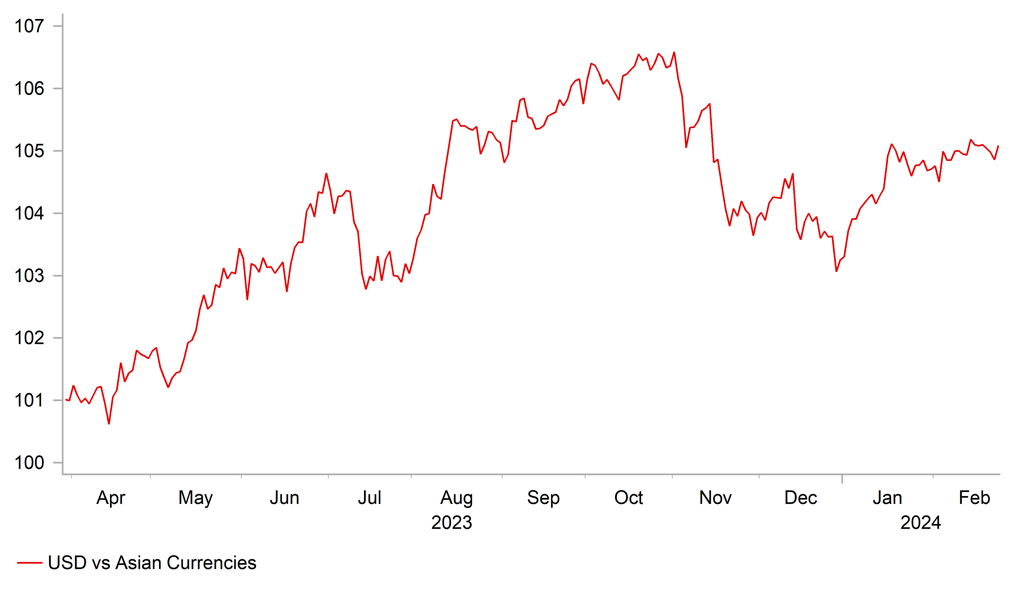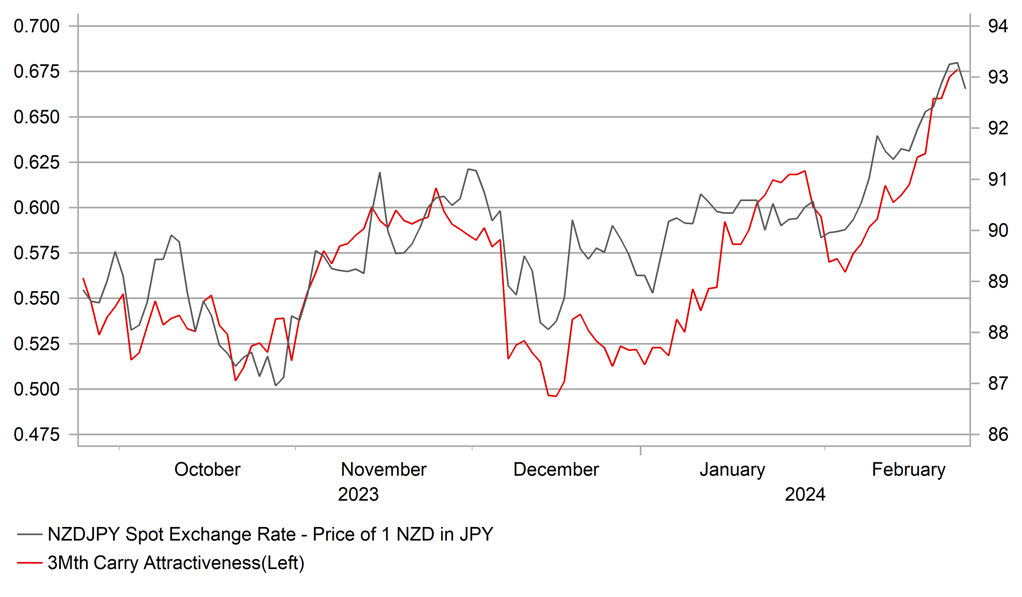USD has lost some upward momentum after strong gains at start of this year
USD: Outlook for Fed policy & global growth in focus
The major foreign exchange rates have remained relatively stable overnight after the US dollar corrected modestly lower last week. It brought an end to five consecutive weeks of gains for the dollar index. The price action highlights that the US dollar has lost some upward momentum in the near-term after staging a strong rebound at the start of this year. The US dollar has benefitted from the hawkish repricing of Fed policy expectations. The US rate market has moved to price in later and less deep Fed rate cuts this year. The expected timing of the first rate cut has been pushed back to June, and the expected number of rate cuts has moved more into line with the Fed’s own plans for three cuts (around 85bps of cuts are currently priced in) by the end of this year. The hawkish repricing of Fed policy expectations has been encouraged by the recent run of strong US economic data releases which has cast some doubt on the need for Fed rate cuts. At the end of last week, New York Fed President Williams told Axios that “my overall view of the economy basically hasn’t changed based on one month of data”. The comments should help to ease any concerns over a bigger hawkish shift from the Fed at the current juncture. He noted that the Fed expected disinflation to be a “little bumpy” month to month, and that underlying inflation was moving “in the right direction” with signs consistent with it “continuing to come down”. He also expressed the view that he has seen no evidence that the Fed’s longer run neutral policy rate has moved higher or is likely to be higher in the future. On the whole his comments were more dovish than those expressed last week by the Fed Vice Chair Jefferson and Governor Waller. Governor Waller who is normally more hawkish stated that he wants to “verify” that the stronger January data is mostly noise which might take only a couple of more months of data to provide reassurance. Overall, last week’s comments from the Fed leadership still suggest that the Fed is moving closer to lowering rates but the timing of the first cut appears less likely to be delivered before June.
The loss of upward momentum for the US dollar could also indicate less investor concern over weak growth outside of the US. The release of the latest PMI surveys last week from Europe continued to cautiously indicate that activity is picking up at the start of this year in the service sector. Fresh policy stimulus measures are helping to improve sentiment towards China’s economy and equity market as well. The Shanghai composite equity index had rebounded by just over 14% from the low earlier this month prior to the sell-off overnight. At the end of last week President Xi announced that China will use fiscal policy to promote equipment renewals and trade-ins of consumer goods. The consumer goods initiative mainly targets cars and home appliances with central and local governments funding subsidies to producers, distributors and end-consumers. According to a report from Xinhua News Agency overnight, China’s State Council, National People’s Standing Committee and other government agencies have all recently submitted work reports to President Xi. He has called for enhancing the momentum of the economy’s recovery trend. The news will further encourage speculation that additional fiscal stimulus measures will be announced after next month’s 14th National People’s Congress. So far though the developments have failed to trigger a reversal of Asian currency weakness at the start of this year.
ASIA FX SELL-OFF AT START OF 2024 REMAINS IN PLACE

Source: Bloomberg, Macrobond & MUFG GMR
NZD: Will RBNZ policy meeting provide setback for G10 FX carry trades?
Global equity markets have hit new record highs over the past week highlighting that investor risk sentiment continues to improve at the start of this year. The improvement in risk sentiment reflects building optimism over a softer landing for the global economy and further evidence that the emergence of artificial intelligence is helping to boost corporate revenues. The ongoing improvement in global investor risk sentiment is creating a supportive environment for G10 FX carry trades at the start of this year. Bloomberg’s G10 Carry trade index which measures the cumulative total return of a buy-and-hold carry trade position that is long the three highest yielding G10 currencies and is fully funded with short positions in the lowest three yielding G10 currencies has performed strongly so far this year increasing by around 4.0%. It follows a period of poor performance for G10 FX carry trade returns in Q4 of last year (-2.1%). The weak performance of the low yielding G10 funding currencies at the start of this year (JPY -6.4% vs. USD YTD & CHF -4.6%) has helped to boost carry trade returns. The broad-based rebound for the high yielding USD has also been a positive development for G10 FX carry trade returns. At the same time, G10 FX volatility has continued to decline making it more attractive to hold carry trades. G10 FX volatility has fallen back to its lowest level since early in 2022 prior to the Ukraine conflict.
The NZD has been the best performing high yielding G10 currency in February driven not just by favourable conditions for FX carry trades but also by the hawkish repricing of the RBNZ policy outlook. The New Zealand rate market has become more confident this month that the RBNZ will raise rates further in the current tightening cycle even though the policy rate is already the highest amongst G10 central banks at 5.50%. The recent change in market expectations will make next week’s RBNZ policy update even more important than normal. While another rate hike is not expected a soon as this week (8bps of hikes priced in), the New Zealand rate market judges that one final hike in the 1H of this year is now more likely than not (15bps of hikes price in by May). In order to meet those hawkish market expectations, the RBNZ will have to at least deliver a signal that they are more seriously considering raising rates at upcoming policy meetings. At their last meeting in November, the RBNZ had already indicated that “if inflationary pressures were to be stronger than anticipated, the OCR would likely to need to increase further”. The November projections were raised to show the policy rate remaining at higher levels for longer with rate cuts unlikely until Q4 at the earliest.
In the current environment we expect G10 FX carry trades to continue to perform well in the near-term. The main downside risk for the high yielding NZD in the week ahead would be if the RBNZ doesn’t back up hawkish expectations for a further rate hike. Please see our latest FX Weekly report for more details (click here).
NZD/JPY VS. CARRY ATTRACTIVENESS

Source: Bloomberg, Macrobond & MUFG GMR
KEY RELEASES AND EVENTS
|
Country |
GMT |
Indicator/Event |
Period |
Consensus |
Previous |
Mkt Moving |
|
UK |
09:00 |
BoE Breeden Speaks |
-- |
-- |
-- |
! |
|
UK |
11:00 |
BoE MPC Member Pill Speaks |
-- |
-- |
-- |
!! |
|
UK |
11:00 |
CBI Distributive Trades Survey |
Feb |
-33 |
-50 |
! |
|
US |
13:00 |
Building Permits |
-- |
1.470M |
1.493M |
!! |
|
GE |
13:00 |
German Buba President Nagel Speaks |
-- |
-- |
-- |
!! |
|
EC |
16:00 |
ECB President Lagarde Speaks |
-- |
-- |
-- |
!! |
|
JP |
23:30 |
National CPI (YoY) |
Jan |
-- |
2.6% |
! |
Source: Bloomberg

